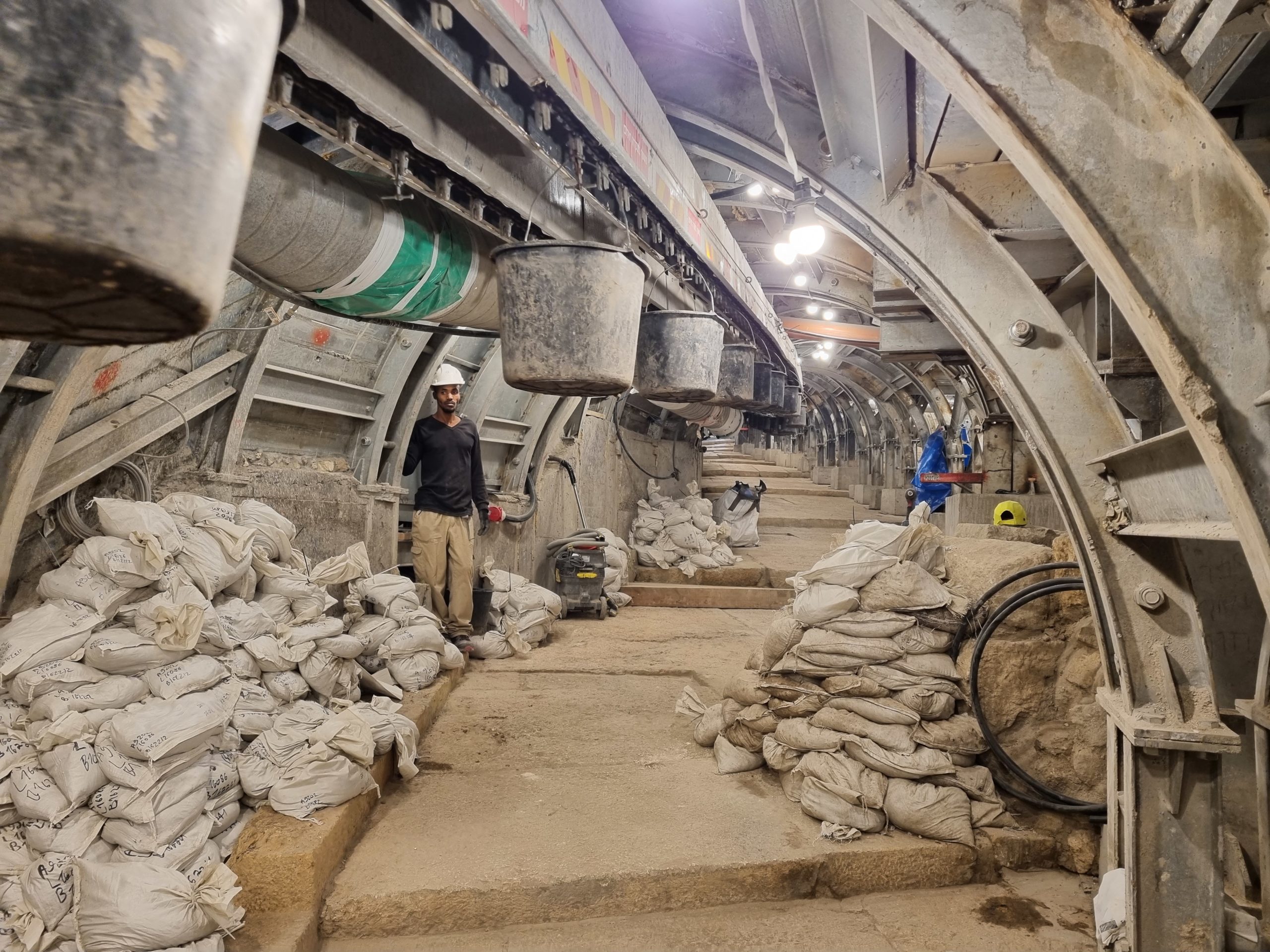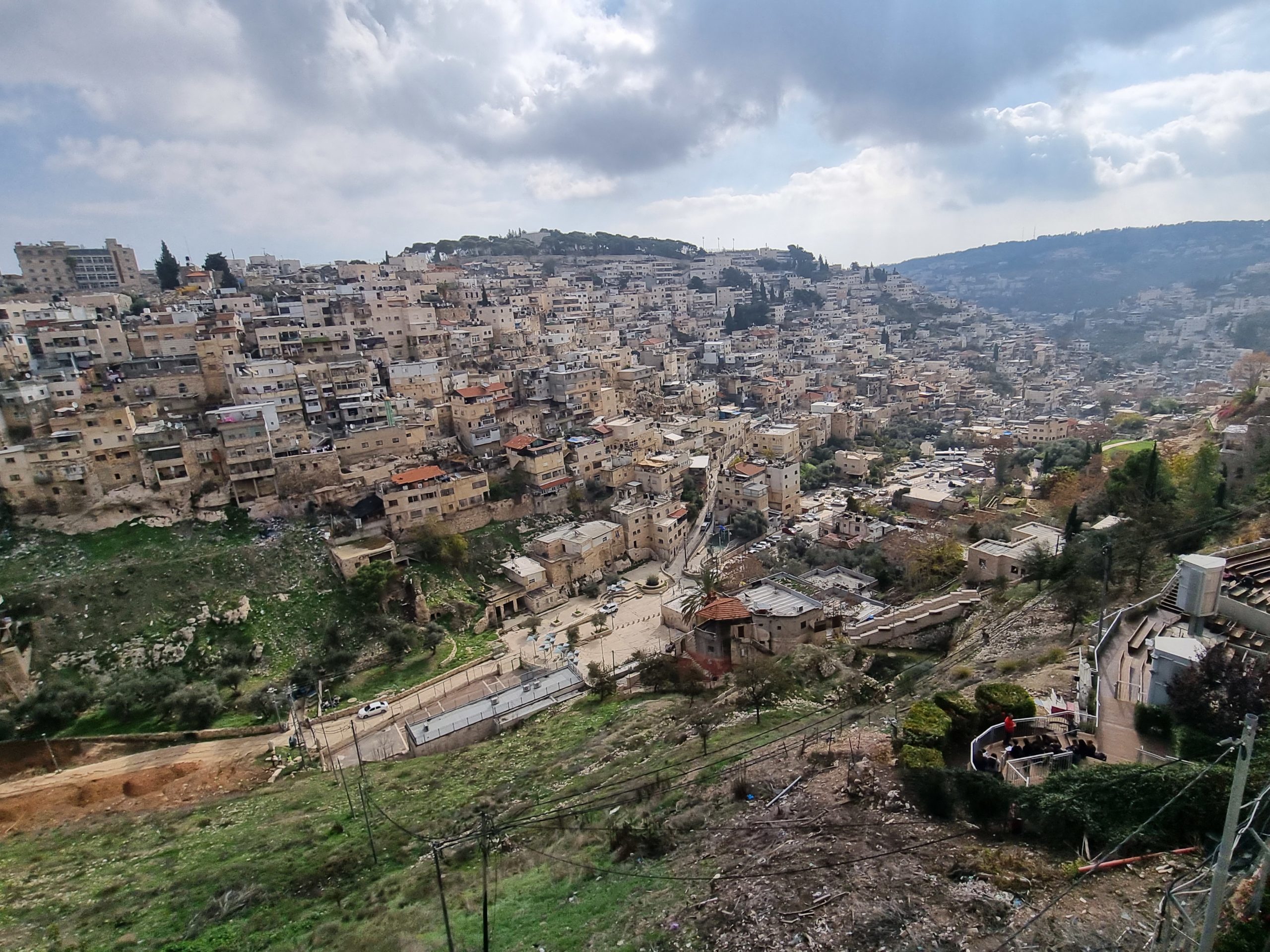This road might not lead to Rome, though it is indeed Roman.
For nearly a decade, archaeologists in Jerusalem’s City of David National Park have been working hard to uncover the Pilgrimage Road and bring a 2,000-year-old journey to life.
 [1]
[1]A view of the Pilgrimage Road at the City of David National Park. The road is undergoing excavations. Dec. 28, 2022. (Maya Margit/The Media Line)
Hidden from view beneath the Arab neighborhood of Silwan, the underground road is marked by stone steps that lead all the way from the Pool of Siloam at the bottom of east Jerusalem’s Silwan Valley up to the foot of the Temple Mount, Judaism’s holiest site.
Also known as the Stepped Street, thousands, if not millions, of Jewish pilgrims once ascended along the ancient path to reach the Temple.
Though the site is not slated to open to the public for another two years, The Media Line recently toured it with archaeologists.
“This road’s length is approximately 600 meters (almost 2,000 feet),” Ari Levy, director of excavations at the site for the Israel Antiquities Authority (IAA), told The Media Line. “We still have approximately 100 meters left [to excavate] to open the entire road for tourists.”
 [3]
[3]Ari Levy, director of excavations at the site for the Israel Antiquities Authority, Dec. 28, 2022. (Maya Margit/The Media Line)
The Pilgrimage Road was rediscovered in 2004 after a sewage pipe burst in the middle of the east Jerusalem neighborhood of Silwan.
Since 2013, archaeologists have been digging right underneath Arab houses in the area, but some residents argue that the excavations have put their homes in danger. The Israeli Supreme Court has dismissed these claims and said that they are being carried out under the strict supervision of engineers.
Workers at the Pilgrimage Road excavation site rely on a complex system of pulleys to help bring dirt up from underground for sifting.
 [4]
[4]Workers fill buckets with dirt from the excavations of the Pilgrimage Road at the City of David National Park, Dec. 28, 2022. These buckets are then transported by a pulley system above ground for sifting. (Maya Margit/The Media Line)
So far, archaeologists have unearthed some unique artifacts, including silver coins that pilgrims would bring as donations to the Temple, cookware, and jewelry.
“Jerusalem in the late Second Temple Period was a flourishing city with a lot of people,” Levy related. “It was a Jewish city and a Roman city. It was built by the Romans for the Romans and for the Jews.”
One of the exciting finds is a replica of a stone with an ancient Hebrew inscription that reads, “to the place of trumpeting to.” This inscription likely marks where a priest would stand on the Temple Mount to announce the start of the Sabbath.
Give the gift of hope
We practice what we preach:
accurate, fearless journalism. But we can't do it alone.
- On the ground in Gaza, Syria, Israel, Egypt, Pakistan, and more
- Our program trained more than 100 journalists
- Calling out fake news and reporting real facts
- On the ground in Gaza, Syria, Israel, Egypt, Pakistan, and more
- Our program trained more than 100 journalists
- Calling out fake news and reporting real facts
DONATE [5]Join us.
Support The Media Line. Save democracy.
The building of Jerusalem during the Roman Period began with the works of Herod the Great, a Roman Jewish client king of Judea who was famous for his massive construction projects throughout the area, including the renovation of the Second Temple in Jerusalem.
After Herod the Great died, sometime between 5 BCE and 1 CE, Roman prefects continued to build up the city. According to Ari Levy, it was in fact the infamous governor of Judea Pontius Pilate who built the Pilgrimage Road.
“At the beginning of the first century CE Pilate basically paves the road that we’re standing on now and connects the southern parts of the city, Mount Zion, and the City of David to the main city itself, the Temple, and other parts of ancient Jerusalem,” he said.
 [6]
[6]A view of the Pilgrimage Road at the City of David National Park. The road is undergoing excavations. Dec. 28, 2022. (Maya Margit/The Media Line)
According to Flavius Josephus, a first-century Romano-Jewish historian, at its peak, nearly 3 million people visited Jerusalem during the main Jewish pilgrimage festivals.
The road was one of the main arteries of ancient Jerusalem and once held a bustling street market.
 [7]
[7]A view of the remains of market stalls along the Pilgrimage Road, Dec. 28, 2022. The road, which leads up to the foot of the Temple Mount, once held a bustling market. (Maya Margit/The Media Line)
“This is the living heart of Jerusalem, this is the Fifth Avenue, this is the Champs-Élysées,” said Dr. Yiftah Shalev, co-director of excavations for the Israel Antiquities Authority. “This is the beating heart of Jerusalem where everything happened.”
 [8]
[8]Dr. Yiftah Shalev, co-director of excavations for the Israel Antiquities Authority, Dec. 28, 2022. (Maya Margit/The Media Line)
At the bottom of the road, archaeologists have also begun excavating the Pool of Siloam. Built some 2,700 years ago during the reign of King Hezekiah, the pool is where Jewish pilgrims once took a ritual bath before making their ascent to the Temple. It is also the site where Jesus is said to have healed a blind man.
Last week, the IAA, National Parks Authority, and City of David Foundation announced the official commencement of excavations of the pool, which once served as the reservoir for the waters of the Gihon Spring. It was considered to be one of the most important areas in Jerusalem during the First Temple Period.
Like the Stepped Street, the Pool of Siloam will be opened to the public for the first time in 2,000 years once excavations are completed.
 [10]
[10]A view of the east Jerusalem neighborhood of Silwan taken from the City of David National Park, Dec. 28, 2022. (Maya Margit/The Media Line)
Altogether, nearly 100 archaeologists and workers are involved in the ongoing excavations of the Pool of Siloam, Pilgrimage Road, and Givati Lot, according to IAA estimates.
The road leads up to the adjacent Givati Parking Lot area, where the layers and levels of thousands of years of settlement in Jerusalem can all be viewed in one place.
“At Givati, you can see remains of all of the periods at the same time,” Shalev said. “You can see exactly how Jerusalem evolved from a relatively small settlement towards a huge city [that was] then destroyed and rebuilt again.
 [11]
[11]Layers upon layers of history are visible at the Givati Parking Lot excavations in the City of David National Park, Dec. 28, 2022. (Maya Margit/The Media Line)
“The idea is not just to expose the road itself but to also leave remains from each and every period so that people will understand what it was like to live in a city like Jerusalem,” he continued. “The newest remains that we’re digging right now are slightly later remains than the road itself. We are digging through houses and structures from the late Roman Period, the Byzantine Period and the early Muslim Period, meaning from the fourth to the sixth centuries CE.”
The Stepped Street winds its way up and reaches Robinson’s Arch and the Western Wall at the nearby Davidson Center Archaeological Park.
It stands just below the Temple Mount and current site of Al-Aqsa Mosque, the third holiest site in Islam.
 [14]
[14]The Davidson Center Archaeological Park, which is under the purview of the Company for the Reconstruction and Development of the Jewish Quarter in the Old City of Jerusalem, is located right on the edge of the Old City, Dec. 28, 2022. Al-Aqsa Mosque can be seen (above) from within the park. (Maya Margit/The Media Line)
A pile of massive stones, which were hurled off the Temple Mount by the Romans, serves as a reminder of the destruction of the Second Temple in the year 70 CE.
 [15]
[15]A view of the massive stones from the Second Temple and part of the Western Wall at the Davidson Center Archaeological Park, which is under the purview of the Company for the Reconstruction and Development of the Jewish Quarter in the Old City of Jerusalem, Dec. 28, 2022. (Maya Margit/The Media Line)
The area around the Old City walls was excavated in the early 1970s following Israel’s capture of east Jerusalem during the Six-Day War in 1967.
“When they started to excavate in the early ’70s, they found all these stones,” Yaniv Levy, a tourism manager at the Company for the Reconstruction and Development of the Jewish Quarter in Jerusalem’s Old City, told The Media Line. “They decided to keep some of the stones to remember the destruction [of the Temple] but at the same time, they wanted to clear the actual road and find where people used to walk 2,000 years ago.
“This the road that the pilgrims walk on, Jesus walks on, and is an amazing piece of history that we can stand on,” he added.
Hundreds of thousands of tourists visit the Davidson Center each year, Levy said. The park holds a unique array of artifacts and places to view, including the original gates that once led to the Temple.
 [16]
[16]A replica of a stone bearing a Hebrew inscription found during excavations at the Davidson Center Archaeological Park, which is under the purview of the Company for the Reconstruction and Development of the Jewish Quarter in the Old City of Jerusalem, Dec. 28, 2022. (Maya Margit/The Media Line)
One of the exciting finds on display is a replica of a stone with an ancient Hebrew inscription – which reads: “to the place of trumpeting to.” This inscription likely marks the place where a priest would stand on the Temple Mount each week to announce the start of the Sabbath.
“At the southwestern corner of the Temple a priest used to go up just before the Sabbath and blow the horn to tell everyone that the Sabbath was coming,” Levy said. “We found the stone that fell from that corner.”
There are still over 300 feet of the Pilgrimage Road left to excavate before tourists can visit and walk in the footsteps of pilgrims from millennia ago.
Until then, visitors can take private guided tours at the City of David National Park, as well as venture to the nearby Davidson Center Archaeological Park for a closer look at Second Temple remains.



